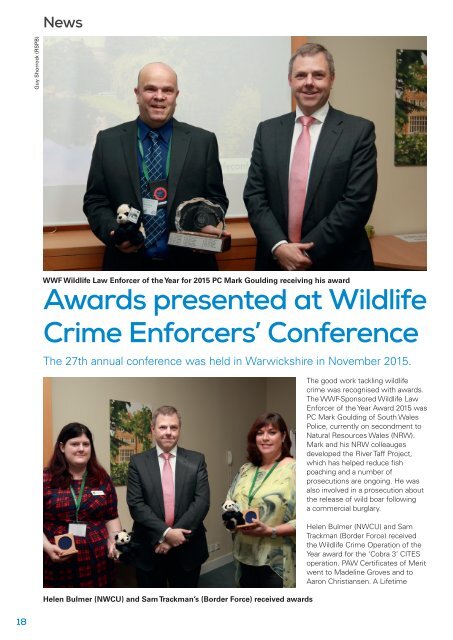Legal Eagle
Legal-Eagle-78_tcm9-416630
Legal-Eagle-78_tcm9-416630
Create successful ePaper yourself
Turn your PDF publications into a flip-book with our unique Google optimized e-Paper software.
News<br />
News<br />
Guy Shorrock (RSPB)<br />
Achievement award went to Sgt<br />
Rob Taylor of the North Wales Police.<br />
Chief Constable Simon Prince said it<br />
was unlikely that wildlife crime<br />
would beceome a policing priority,<br />
but Authorised Professional Practice<br />
(APP) guidance documents were<br />
being prepared for wildlife crime.<br />
Chief Inspector Martin Sims, Head<br />
of the National Wildlife Crime Unit<br />
(NWCU), told about work of his unit<br />
and the levels of intelligence<br />
exchange. Other significant<br />
presentations came from Guy<br />
Clarke of Border Force, Sue<br />
Hemming of the CPS and Alan<br />
Charles, the Police Crime<br />
Commissioner for Derbyshire. There<br />
was the usual interesting mix of<br />
case studies and workshops.<br />
the capacity of the statutory<br />
agencies to address wildlife crime.<br />
The project is grateful for support<br />
from Procurator Fiscal Kate Fleming,<br />
the NWCU, DC Sarah Bailey of the<br />
Metropolitan Police Wildlife Crime<br />
Unit and the Border Force CITES<br />
Team at Heathrow.<br />
Once again, big thanks to<br />
Craig Fellowes of the Wildlife<br />
Training Consultancy for organising<br />
the event, and for the additional<br />
financial support provided by the<br />
World Animal Protection and<br />
the Humane Society International.<br />
Guy Shorrock (RSPB)<br />
WWF Wildlife Law Enforcer of the Year for 2015 PC Mark Goulding receiving his award<br />
Awards presented at Wildlife<br />
Crime Enforcers’ Conference<br />
The 27th annual conference was held in Warwickshire in November 2015.<br />
The conference welcomed Greek<br />
Customs officer, Petroula Pyrgi.<br />
Her six-day UK visit was funded<br />
by an EU LIFE project, Return of<br />
the Neophron, about the survival<br />
of Egyptian vultures in the Balkans.<br />
Part of the project seeks to improve<br />
Fingerprinting ivory<br />
Sgt Rob Taylor with his PAW Award and Chief Constable Simon Prince<br />
New techniques for retrieving fingerprints from ivory have been developed.<br />
Helen Bulmer (NWCU) and Sam Trackman’s (Border Force) received awards<br />
The good work tackling wildlife<br />
crime was recognised with awards.<br />
The WWF-Sponsored Wildlife Law<br />
Enforcer of the Year Award 2015 was<br />
PC Mark Goulding of South Wales<br />
Police, currently on secondment to<br />
Natural Resources Wales (NRW).<br />
Mark and his NRW colleauges<br />
developed the River Taff Project,<br />
which has helped reduce fish<br />
poaching and a number of<br />
prosecutions are ongoing. He was<br />
also involved in a prosecution about<br />
the release of wild boar following<br />
a commercial burglary.<br />
Helen Bulmer (NWCU) and Sam<br />
Trackman (Border Force) received<br />
the Wildlife Crime Operation of the<br />
Year award for the ‘Cobra 3’ CITES<br />
operation. PAW Certificates of Merit<br />
went to Madeline Groves and to<br />
Aaron Christiansen. A Lifetime<br />
Scientists from King’s College<br />
London and University College<br />
London have collaborated with<br />
imaging and fingerprint experts from<br />
the Metropolitan Police to validate<br />
the use of new techniques.<br />
Their findings, published in the<br />
journal Science and Justice, could<br />
lead to the wider use of<br />
fingerprinting methods in the field.<br />
This should help to identify poachers<br />
in regions with high levels of<br />
ivory-related crime. Ivory itself is a<br />
highly porous and ridged material,<br />
so fingerprints enhanced with<br />
conventional powders have been<br />
largely ineffective.<br />
In recent years, newer powders<br />
with smaller particles have been<br />
developed, and these show more<br />
detail, as they require less finger<br />
mark residue. The latest study<br />
tested three types of powders<br />
on elephant tusks loaned by the<br />
Metropolitan Police Wildlife Crime<br />
Unit. It was found that two of the<br />
newer powders were able to give<br />
the clear, useable fingerprint detail<br />
that is vital for identifying the donor.<br />
The clarity of ridge detail was at its<br />
highest within seven days after the<br />
print was deposited, so the method<br />
is likely to work best in regions of<br />
the world that are closest to the<br />
sources of ivory. However, with<br />
the new powder, imaging and<br />
fingerprint experts were able to lift<br />
some useable prints up to 28 days<br />
after they were deposited.<br />
The researchers showed how the<br />
powders could be used with rhino<br />
ivory, hippo teeth and sperm<br />
whale teeth.<br />
It is hoped that new fingerprinting techniques for ivory<br />
will help bring wildlife criminals to justice in the future<br />
Metropolitan Police<br />
18<br />
19


